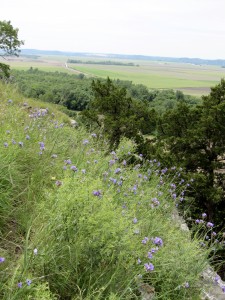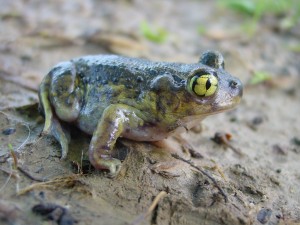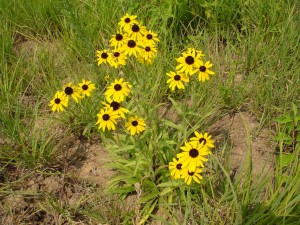Preservation of Local Hill Prairies Will Make Mother Nature Smile
The bluffs of Monroe, Randolph and St. Clair Counties contain 40% of the hill prairies in the state of Illinois. They are also unique because they harbor a special group of herpetofauna (reptiles and amphibians), plants, and an invertebrate, many of which aren’t found elsewhere in Illinois. Many of these plants and animals are common in states south and west of here, but reach the northern or northeastern-most part of their range in southwestern Illinois.
The existence of the hill prairie, cliff, and limestone glade communities along the bluffs, and their associated talus (loose rocky debris at the bottom of a cliff) and ledge habitat creates favorable accommodations for many of these plants and animals. Additionally, Illinois’ Pleistocene glaciers didn’t quite reach the Monroe-Randolph-St. Clair bluff corridor, leaving a landscape that resembles the Missouri Ozarks more than it does the rest of Illinois.
Species of statewide significance in the Monroe-Randolph-St. Clair bluffs include:
- Coachwhip Snake – Illinois Endangered – only known state records are from 3 locations in the Monroe County bluffs
- Great Plains Rat Snake – Illinois Endangered – found only in Monroe, Randolph, and Jersey Counties on the bluffs
- Flathead Snake – Illinois Threatened – only known in Monroe and Union Counties, in bluff and associated talus habitat
- Eastern Narrowmouth Toad – Known from only 4 counties, Monroe, Randolph, Pope, and Hardin
- Eastern Spadefoot Toad – Found in 9 Illinois Counties with Monroe being northern-most location
- Timber Rattlesnake – Illinois Threatened – Still found in 21 Illinois Counties but declining greatly over its entire range
- Missouri Coneflower – Illinois Threatened – Only found in the Monroe-Randolph County bluffs
- Woolly Buckthorn – Illinois Endangered – Only found in the Monroe County bluffs
- Slender Heliotrope – Illinois Endangered – Only found in the Monroe-Randolph County bluffs
- Dwarf Bedstraw – Illinois Endangered – Only found in the Monroe County bluffs
- Stickleaf – Illinois Endangered – Only found on unglaciated limestone bluffs in 5 Illinois Counties along the Mississippi River, including Monroe and Randolph
- Common Striped or “Plains” Scorpion – Illinois Endangered – Only known from the Monroe-Randolph County bluffs
- Crested Coralroot Orchid – Illinois Endangered – Only known from 9 locations in 4 counties, including 3 sites in the Monroe County bluffs and 3 in the Randolph County bluffs
- Wedged-leaf Whitlow Grass – Illinois Endangered – Only found on limestone bluffs in 5 Illinois Counties along the Mississippi River, including Monroe and Randolph
Aside from these unique plants and animals, over half of Illinois’ 102 herpetofaunal species are found in Monroe, Randolph and St. Clair Counties along the bluff corridor. This includes more than 60 types of toads, frogs, lizards, salamanders, snakes, and turtles. In addition, the relatively unbroken mosaic of forest and hill prairie along the bluffs provides important habitat for a large variety of birds. Several of these bird species need this area’s unusually large forest tracts or the towering rocky cliffs for successful nesting.
What is a Hill Prairie?

Spiderwort blooms in abundance at Overlook Prairie on the White Rock Nature Preserve. Photo courtesy Susan Rick
A hill prairie is a type of natural community known only to occur along the bluffs of major rivers and tributaries in the Midwest. That makes our region the global home of this unique kind of natural area.
A combination of factors are necessary to create hill prairies. Generally, a south/west facing exposure is essential for hill prairie formation. Add to this, sites that are perched above a broad floodplain which delivers brisk, southerly winds up the slopes, and a well-drained soil, often composed of loess (a wind-blown glacial silt)–all of which collectively create hot, dry conditions that generally favor prairie plants over trees. Fire is the final natural component that tips the balance in favor of grassland over forest. Nearly 100 prescribed burns have been safely conducted in the bluffs to help manage prairies.
An Uncertain Future
Unfortunately, many of the bluffs in Monroe, Randolph and St. Clair Counties are threatened by residential and other types of development. Aside from these physical threats, many hill prairies are declining in size due to invasion from native trees and shrubs. Today, most fire has been eliminated from our landscape and without it, trees and shrubs can often get a foothold on many of our hill prairie sites. Reintroducing prescribed fire is an essential tool in preserving our hill prairies for the future. In situations where many trees and shrubs have established on a prairie site, fire may need to be initially accompanied by cutting and treating the woody plants.
Non-native invasive plants are also threatening hill prairies and surrounding woodlands. Sweet clover, Japanese hops, mimosa tree, bush honeysuckle, and tree-of-heaven are serious problems at many of our hill prairies. These are currently the worst invasive species, but several others threaten to expand their damaging effect on our bluffs. Reducing the destructive impact of these plants on our beloved bluffs requires attention from all bluff landowners.
Currently, parts of seven hill prairie complexes and associated bluff habitats in Monroe, Randolph and St. Clair Counties are legally and permanently protected as Illinois Nature Preserves or Illinois Land & Water Reserves. Eleven of these preserves and reserves are privately owned; 2 are owned by state or local government and 2 are owned by non-profit groups. Three of the 4 non-private sites are open to the public (Salt Lick Point LWR, White Rock NP, and Fults NP).
Protection and management of more prairies and associated woodland along the Monroe-Randolph-St. Clair County bluff corridor must occur if we are to fulfill our responsibility to protect this unique statewide and international treasure.
CLIFFTOP, a local nonprofit organization, is focused on preserving and protecting area blufflands.
A version of this article appeared in the February 2, 2018, edition of the Monroe County Independent.
© 2018 all content rights reserved Clifftop NFP
Comments are currently closed.


